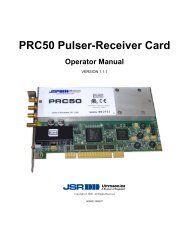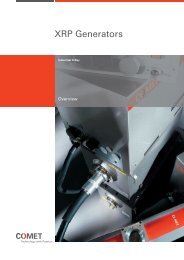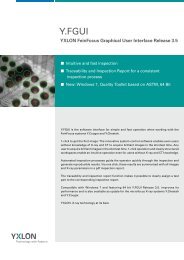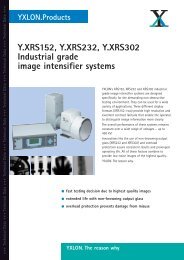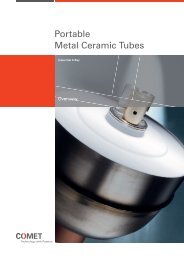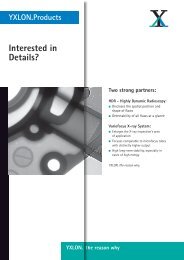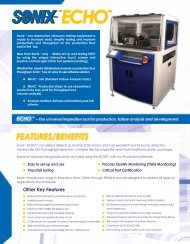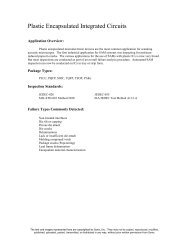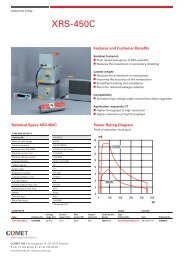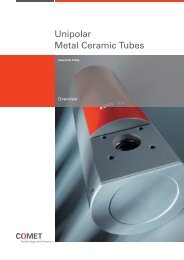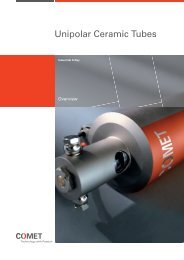Molded Flip Chip Imaging
Molded Flip Chip Imaging
Molded Flip Chip Imaging
- No tags were found...
You also want an ePaper? Increase the reach of your titles
YUMPU automatically turns print PDFs into web optimized ePapers that Google loves.
Application Note 010MFCI Page 1 of 2IntroductionFor many years, flip chip packages have mostcommonly been inspected in a bare die state. Thishas allowed for higher frequency transducers (e.g.200 MHz and higher) to be used to ultrasonicallyinspect for solder bump defects (such as cracks,voids, or disconnects) and underfill defects (such asvoids and filler particle density concentrations).However, the newer, more advanced flip chippackages with their thin die, new dielectric layers,and overmolding offer challenges to the traditionalmode of inspection.<strong>Molded</strong> <strong>Flip</strong> <strong>Chip</strong>sFiller particles added to molding compounds andunderfill compounds to improve their thermalproperties (conductivity and expansion) deflectultrasonic signals. As the ultrasonic beampropagates though the mold compound, it scattersoff of the filler particles weakening the signal orblocking it altogether (Figure 1). This scatteringeffect causes shadows of the filler particles to beseen in images from the interfaces of interest (suchas the die top, die-to-bump and bump-to-substrate),and prevents accurate inspection. In many cases, thefiller particles are larger than the solder bumps / Cupillars to be inspected limiting the ultrasonicinspection capability. The solder bumps / Cu pillarsmay be hidden by a filler particle shadow. Using alower frequency transducer, such as the S1463 75MHz 12mm, can help with penetrating through themold compound, but there will still be some shadoweffects in the resulting images that limit theinspection.particle shadow effect, features below PI layervariations may be concealed in typical ultrasonicimages. When a PI layer is present in anovermolded flip chip, the effect of both materialscan make standard ultrasonic inspection quitechallenging. When inspecting a bare die samplewith a PI layer, UHF frequencies can usually still beused, but a longer focal length is often necessary topenetrate to the interfaces of interest. However, formore attenuative PI layers or if both the PI layer andmold compound are present, a lower frequencytransducer, such as the S1463 75 MHz 12mm, willhelp with penetration to the interfaces of interest.DieMold CompoundSubstrateTransmitted SignalWeakened SignalStrong Reflected SignalWeak Reflected SignalFigure 2: Schematic of a molded flip chip with a PIlayer and the PI layer weakening effectMold Compound withlarge filler particlesDieSubstrateTransmitted SignalReflected SignalLost SignalFigure 1: Schematic of the layers in a molded flipchip and the filler particle scattering effectPolyimide (PI) LayerThe addition of a PI Layer weakens the ultrasonicsignal passing through it, reducing image contrast ofthe interfaces of interest below it. In some cases,shadows of PI layer variations are visible,preventing accurate inspection. As with the fillerFigure 3: (top) standard ultrasonic image of amolded flip chip, (bottom) MFCI image of themolded flip chip showing improved spatialresolution and contrastSonix, Inc., 8700 Morrissette Drive, Springfield, VA 22152Phone: (703) 440-0222 Fax: (703) 440-9512 Email: support@sonix.com
Application Note 010MFCI Page 2 of 2MFCI TechniqueBy examining the physics of the ultrasonic beaminteraction with the mold compound and with the PIlayer, Sonix has been able to develop a moldedflip chip imaging (MFCI) technique for reducingthe scattering and attenuation effects of the moldcompound and PI layer. Images produced using theMFCI technique show improved spatialresolution and contrast (Figure 3) as well as betteredge resolution (Figure 4) .NoteThe MFCI technique, when present on a SonixSAM system is activated under the Advanced menuitem.Figure 4: (top) standard ultrasonic image of avertical line feature in a calibration sample,( bottom) MFCI image of the same vertical linefeature showing much cleaner edge resolutionDiscussionAlthough the MFCI technique was developed toaddress molded flip chip imaging issues, it has beenfound to improve spatial resolution, contrast, andedge resolution in any images that require goingthrough a layer with particles or other scatteringeffects. An example of such a material is flip chipunderfill, which also contains filler particles.Images of the solder bumps / Cu pillars within theunderfill layer or at the substrate interface areimprovedwhen using MFCI.Sonix, Inc., 8700 Morrissette Drive, Springfield, VA 22152Phone: (703) 440-0222 Fax: (703) 440-9512 Email: support@sonix.com



